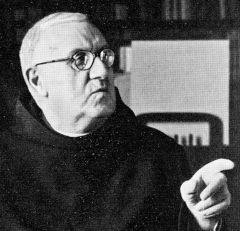Maria Laach and the Liturgical Movement
The best years of Maria Laach's liturgical movement was certainly not characterised by experiments, as one imagines liturgical movement today, but by solid historical research and monastic spirituality. We find ourselves after the First World War in the then booming and spiritually active abbey on Lake Laach.
The fact that a Benedictine of the abbey, Leo Cunibert Mohlberg (1878-1963), who was born in Cologne, is now being pulled out of the darkness of history is to the credit of Stefan K. Langenbahn, a long-time contributor to the "Archiv für Liturgiewissenschaft". In three powerful articles in this "Archive" - in the 2018, 2019 and 2020/21 volumes - he has brought the confrere, ostracised by the supposedly more famous Father Odo Casel, back into the light and in a certain way also rehabilitated him. This is particularly important because the name of Romano Guardini is inseparably linked with Mohlberg, not Casel. Mohlberg and Guardini worked closely together, especially in their younger years. An extensive correspondence awaiting publication bears witness to this.
Mohlberg was basically the head of historical liturgical science as it emanated from Laach. That Casel bit him off as early as 1921/22 to make way for his mystery theory is to be regretted. The Holy See profited from this. Giovanni Mercati brought Mohlberg to Rome to the Vatican Library for the edition of the olf Roman sacramentaries, and in 1930 he became a successful professor of liturgical history and hagiography at the Pontifical Institute for Christian Archaeology, where he worked almost until his death in 1963 and had numerous students.
In Laach, people felt they were on the better side anyway. The conceit of the knowledgeable, the "gnostics" of mystery theory, were united in belonging to the elite. Abbot Herwergen wrote it bluntly to Casel almost exactly 90 years ago on 30 July 1932: "Of the actually deeper content of the liturgy, P[ater] C[unibert Mohlberg], despite his certainly creditable historical knowledge, understands next to nothing".
The waves of the last Council have caused Mohlberg to fall completely into oblivion. That the Council implemented his liturgical ideas can neither be affirmed nor denied. Mohlberg was far too stubborn a mind to allow himself to be harnessed to the cart of a particular reform movement. In any case, Annibale Bugnini studied at the Pontifical Institute in the very years when Mohlberg was not teaching there because he had to stay in Switzerland due to the war. Mohlberg had attracted attention because he had made statements against National Socialism that were too open-hearted for him to dare return to Italy or even Germany.
- Stefan K. Langenbahn, Die Anfänge der modernen Liturgischen Bewegung im deutschen Sprachraum und ihre "akademische Phase" bei Romano Guardini im Spiegel der Quellen, Teil 1, in: Archiv für Liturgiewissenschaft 60 (2018) 34-100.
- Stefan K. Langebahn, Die Anfänge ..., Teil 2, in: Archiv für Liturgiewissenschaft 61 (2019) 47-97.
- Stefan K. Langenbahn, ... damit wir endlich einen Kristallisationspunkt für wissenschaftliche Liturgik haben". Romano Guardini als Promotor und Cunibert Mohlberg als Organisator des Jahrbuchs für Liturgiewissenschaft, in: Archiv für Liturgiewissenschaft 62-63 (2020-2021) 18-70.
It is very regrettable that Langenbahn's lecture on Maria Laach in the Third Reich and Herwegen at the RIGG conference "Cult of the People" will not be published in the conference proceedings, which will appear in autumn.
S. Heid will publish articles on the history of the liturgy chair and Mohlberg at the Pontifical Institute for Christian Archaeology next year with a view to the centenary of the Institute.
- Details
- Written by: Stefan Heid
- Category: From around the world
 Römisches Institut der Görres-Gesellschaft
Römisches Institut der Görres-Gesellschaft







